Chalo
100 TW
For stick welding, I'd recommend a minimum wall thickness of .100 (2.5mm). 1/8" wall is very easy to find in the USA. That's fine, but 3x as thick as it would need to be if you used fillet brazing or TIG welding.
Ok. Does that mean you could go thinner than 2.5mm with TIG or brazing?For stick welding, I'd recommend a minimum wall thickness of .100 (2.5mm). 1/8" wall is very easy to find in the USA. That's fine, but 3x as thick as it would need to be if you used fillet brazing or TIG welding.
1/8" = 3.175mmFor stick welding, I'd recommend a minimum wall thickness of .100 (2.5mm). 1/8" wall is very easy to find in the USA. That's fine, but 3x as thick as it would need to be if you used fillet brazing or TIG welding.
Yes - specific diameters, lengths and wall thicknesses (in steel, titanium, and aluminum).Is the head tube and bottom bracket tube special diameter, i mean can it not be brought as a normal tube from a metal shop?
no I watched it. i just wanted to make sure. it just seems like some company should have started rolling that tube out by now. i just wanted to make sure it was actually necessary. i watched the video!. thanks lolYes - specific diameters, lengths and wall thicknesses (in steel, titanium, and aluminum).
Frame builders supply i.e. Framebuilder Supply
... or, hacked from existing frames.
Apparently you failed to watch the last video link I posted?
Thanks for the info its appreciated and makes sense. You do have a lot of threads you could link me to some from your build. i would like to see the weight you are carrying.It's certainly possible to guesstimate and build a frame, and use whatever materials and tools are at hand; I've done this successfully twice (out of several attempts) and evolved the results over several years into the CrazyBike2 and the SB Cruiser heavy cargo trike.
Neither one is optimal, or remotely well-designed or built, but they work. (CB2 took a lot of iterations to get to that point, SBC I'd learned enough from the others by then to make it usable from the beginning, though I've had several structural issues with it, including one major structural failure (that repeated itself due to a poorly implemented repair).
I'm terrible at stick welding so I use a flux-core wirefeed welder (the cheap crap from harbor freight), and most of my welding is serviceable...but it is hard even with this to weld regular bike tubes or other thin metal without lots of burn thru, that I then have to go back and fill in. Tends to look like crap, but most of the welds don't fail. :lol: (well, the *welds* never fail but the metal around them certainly has, for various reasons).
I have threads for my various builds here, if you're interested in them.
Most of what I use is old bike frames as sources of parts and metal, but I also use whatever scrap steel I run across--most of *that* is junk, and has often been a mistake to use...but some of it worked out ok. What didn't work has broken usualy near a weld, or just been so flexible or soft that it couldn't support what it needed to.
If you already have the stuff you can always try what you're intending, and if it doesn't work out, then try something else.
But, based on my own experiences...depending on your intended usage (rinding conditions, speed, etc.) then if this is the first frame you've welded up, you might want to be careful and ride where you can test things out with no chance of unexpected interactions with other people, bikes, vehicles, etc.And expect things to break, in ways you didn't even think of, etc.
Regarding the bike by the builder/company saying he started his company because he broke ohter bikes...if he doesn't state specifically which bikes (model, year, etc) and exactly how each was broken (physically, electrically, etc) and under what specific conditions, then you dont' really know if his *frame* is "overbuilt", or, if it is "overbuilt", what specific conditions it's overbuilt for. :/
For instance, I'm pretty sure that the pictured bike above couldn't handle the cargo loads i'd need it for, even under smooth road conditions (which we don't have in most of the places I have to ride--they're not usually terrible but they're certainly not perfect). It would have to be heavily modified (not counting just adding the cargo carriers).
How could this frame be any stronger than the one I posted, Does the round bar make all that difference?Banana seat a Mongoose Argus MX 20 Inch BMX Fat Tire Kids, feeling fancy then extend its wheel base a bit for a warm up. Frame has a note on easy welding skills - "durable steel kids frame" make your own battery box frame.
You do have a lot of threads you could link me to some from your build. i would like to see the weight you are carrying.

 endless-sphere.com
endless-sphere.com

 endless-sphere.com
endless-sphere.com

 endless-sphere.com
endless-sphere.com

 endless-sphere.com
endless-sphere.com

 endless-sphere.com
endless-sphere.com

 endless-sphere.com
endless-sphere.com

 endless-sphere.com
endless-sphere.com

 endless-sphere.com
endless-sphere.com




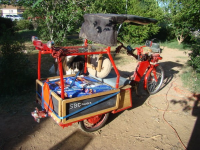

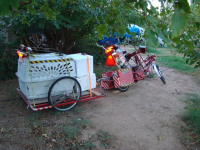
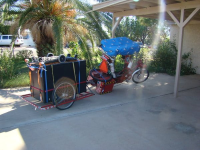

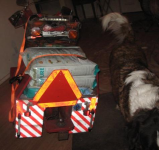
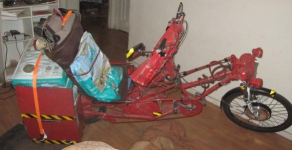
A Piano!
The SB Cruiser : Amberwolf's 2WD Heavy Cargo Trike & Dog Carrier
This thing replaces Delta Tipper...er, Tripper v1.0, whcih was cannibalized to build it. https://endless-sphere.com/forums/viewtopic.php?f=2&t=22720 It's mostly Dogman's fault ;) ...er, inspiration, as he suggested it as a joint build for his trip out here this year. Tiny and Yogi discuss...endless-sphere.com

SB Cruiser Mk II design ponderings
This may not remain titled the same, but for now, SB Cruiser Mk II will do to get the idea across. :) So...I've been rebuilding the original SB Cruiser here: https://endless-sphere.com/forums/viewtopic.php?f=2&t=67833&start=350#p1227053 to fix a bunch of "little things" and make it more useful...endless-sphere.com

Amberwolf's Cloudwalker Cargo Bike
This thread will be for the re-evolution of what used to be CrazyBike2: https://www.endless-sphere.com/forums/viewtopic.php?f=2&t=12500 which looked approximately like this (but all red) last time it was working: and now looks like this: Since the stuff I'll need to begin building the new...endless-sphere.com

2WD Semi-Recumbent Recycled-Parts Cargo eBike: "CrazyBike2"
This is a project that's been in the works since the beginning of this year, based partly on previous projects, partly on web research, but mostly on whatever I happened to have on hand when I started it, and what I acquire as I go along. I already posted a series of pics including how it looks...endless-sphere.com

Amberwolf's Raine Trike
This will be a smaller lighter version of the SB Cruiser: https://endless-sphere.com/forums/viewtopic.php?f=2&t=67833 built as a grocery-getter/etc for my sibling Raine. It doesn't have to carry the kinds of loads SB Cruiser does, and probably wouldn't be used on the roads at the 20MPH I ride...endless-sphere.com

Amberwolf's Flatbed Kennel Trailer Mk III
Previous versions are here: http://www.endless-sphere.com/forums/viewtopic.php?f=2&t=18671 and here: http://www.endless-sphere.com/forums/viewtopic.php?f=2&t=54323 but now that I've got a second, bigger St Bernard (Yogi), in addition to Tiny, I kinda need a bigger trailer, too. I already needed...endless-sphere.com

Amberwolf's Flatbed Kennel Trailer Mk IV
This will be a new larger version, primarily for Yogi. Previous versions are here: http://www.endless-sphere.com/forums/viewtopic.php?f=2&t=18671 and here: http://www.endless-sphere.com/forums/viewtopic.php?f=2&t=54323 and here: https://endless-sphere.com/forums/viewtopic.php?f=2&t=63781...endless-sphere.com

Amberwolf's Flatbed Kennel Trailer Mk V
New version for the dogs; usable for cargo too, with removable air conditioning for the dogs (if the parts I have work out). Previous versions are here: https://endless-sphere.com/forums/viewtopic.php?f=2&t=18671 and here: https://endless-sphere.com/forums/viewtopic.php?f=2&t=54323 and here...endless-sphere.com
View attachment 345186 View attachment 345187
Yes. I had to mod the trailer to carry that; you can see the changes in the Mk IV trailer thread.A Piano!
Gluing thin stuff is relatively easy if the proper technique is applied. Yes, even .062 (remember those exercise frames I mentioned AW? many are .062"). The technique is called continuous stitch welding... The secret?.... Do not allow excess heat to increase unnecessarily under the arc - if you burn-through, you're either going too slow, back-tracking, or amps too high. Resist the urge to stop and fill-in a molten crater you just created - Just keep going, and fill it after it has cooled.I'm terrible at stick welding so I use a flux-core wirefeed welder (the cheap crap from harbor freight), and most of my welding is serviceable...but it is hard even with this to weld regular bike tubes or other thin metal without lots of burn thru, that I then have to go back and fill in.

0.9mm (.035") wall straight gauge tubing is the baseline for most inexpensive chromoly steel frames. Butted tubing is usually 0.9/0.7/0.9 unless it's fancy/expensive (thinner).1/8" = 3.175mm
divided by 3 is 1mm
surely that is too thin to build a bike with! 3mm seems ok to me for thickness.The bike is reinforced with plate as well but i would like to get an idea of the required thickness.
Thank you.
Thanks a lot for the information, I think i will cut up some bikes. i have two that i collected for free.0.9mm (.035") wall straight gauge tubing is the baseline for most inexpensive chromoly steel frames. Butted tubing is usually 0.9/0.7/0.9 unless it's fancy/expensive (thinner).
I used a mix of 0.9mm and 1.25mm (.049") wall chromoly tubing for my cargo e-bike frame, but I used the thicker kind only because it was easy/cheap for me to get. The pedicab manufacturer I used to work for prototyped all the trikes in 0.9mm tubing, but went into production with 1.25mm to add structural margin.
I think you should cut up some cheap junky frames made of mild steel ("high tensile" in bike industry jargon) so you can see for yourself what thicknesses are used for mass market bikes.
If you miter and sand off the pieces you cut up, you can try stick welding them to see if it's feasible. My guess is it won't work with normal bike tubing, but I haven't tried it, so I can't say so with certainty.Thanks a lot for the information, I think i will cut up some bikes. i have two that i collected for free.
Skinny, small diameter rods? Cut'em in half w/dremel or angle grinder w/cut-off disk. And use both hands on the stinger grip.Thin rods obviously are more flexible so use one hand to hold the rod clamp and the other hand to steady the rod near the weld process.
When you start playing with .049 and thinner, you'll need to use O/A (I use O/P) torch, or gtaw
